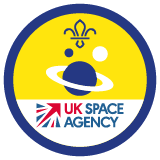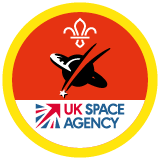
Peake performance
You’ll need
- Clean items of recycling
- Glue sticks
- Sticky tape
- Scissors
- Cones
- Stopwatch
- Blindfolds
- Litter picker
- Small items (such as balls, empty bottles, and boxes)
Before you begin
- Transform your meeting place into the International Space Station (ISS) by setting up four bases named after different modules on the ISS: Zvezda, Quest, Kibo, and Canadarm2.
- It’s best to have a helper at each base to help the astronauts in training. You could ask parents and carers to help if you don’t have enough people.
- Zvezda: put a pile of clean items of recycling, glue, and sticky tape at the base.
- Quest: set up a short course using cones, and leave a stopwatch.
- Kibo: print the Kibo language sheet and cut out the Russian words and English translation. Put the alphabet sheet and the cut out words at the base.
- Canadarm2: a litter picker (or two poles), blindfolds, a selection of small items.
Welcome to training
- Everyone should split into four groups.
- The person leading the activity should use the space facts sheet to explain that Tim Peake is a British astronaut who went to space for a six-month mission. They should tell everyone about the International Space Station, and explain that everyone will have a go at four bases with tasks like astronaut training.
- Each group should start at a different base. After about 15 minutes, the person leading the activity should make a signal and everyone should move to the next base.
15 minutes is just a guide – you can vary the time depending on your group.
- Everyone should have a turn at each base, and then everyone should come back together and share what they learned.
Zvezda: building the ISS
- The International Space Station has been built since 1998, one piece at a time. Seventeen countries work together to build parts on Earth, launch them into space with rockets, and attach them to the station while it’s in orbit.
- Just like the countries that work to build the ISS, each group should build part of a model of an ISS.
- The first group should use some of the models to start building a space station.
If any group gets stuck, they could think about where the astronauts sleep, how the station’s powered (solar panels), and where the astronauts carry out experiments. For example, people could use foil to make solar panels or empty bottles and boxes to make modules.
- The other three groups should add on to the model; by the end of the meeting all four groups will have helped to build one big model.
- Once the model is finished and everyone’s finished admiring it, someone should dismantle it so the pieces of recycling can be recycled.
Quest: spacewalk relay
- When Tim Peake got to the ISS he had to move around in low gravity, which feels very different to walking on Earth. Astronauts coordinate their hands, arms, and feet to push and pull themselves from one place to another without floating away. The bear crawl and crab walk increases muscle strength and improves upper and lower body coordination.
- Everyone should try the bear crawl. They should walk on all fours facing down. They should move diagonally opposite feet and hands at the same time – for example they should move their left hand and right foot forward at the same time, and then move their right hand and their left foot together.
- Everyone should try the crab walk. They should sit with their bottoms on the floor and their feet flat on the floor in front of them. They should put their hands behind them, bend their knees, and push with their hands and feet to lift their bottom off the floor. They should move their hands and feet together in diagonal opposites (like in the bear crawl; left hand and right foot then right hand and left foot) to scuttle backwards.
- The first person in the group should bear crawl through the cone course, then crab walk back through the course to the rest of their team. When the first player returns, the second player should go, and so on until everyone’s had a turn.
- A helper should time each team to see how fast they can finish the course.
Kibo: cosmic communication
- ISS uses two official languages to communicate with mission control – English and Russian. All new astronauts heading to the ISS travel in the Russian Soyuz rocket, so they need to know some Russian and some English. Tim Peake say this was the hardest part of his training; he doesn’t find learning languages easy.
- Everyone should look at the Russian alphabet sheet and have a go at making the sounds.
- Everyone should work together to sound out all of the Russian words and match them to their English translations.
- Once they’ve matched the words, everyone should try to write their name using the Russian alphabet (Cyrillic).
- Before they leave the base, everyone should jumble the Russian and English words back up, so the next group can play.
Canadarm2
- Canadarm2 is a robotic arm that’s used to move cargo and help with maintenance.
- Canadarm2 is made of millions of pounds of robotics, but at this base the group should use a littler picker or even two poles (used like chopsticks) to make a robot arm.
- The group should choose one person to be blindfolded and work the robotic arm.
- The helper at the station should put some small items like small balls, empty bottles, and small boxes around the floor.
- The group should direct their blindfolded teammate to use the robotic arm to pick up all of the small items.
- Tim Peake blasted off into space on 15 December 2015. He joined the International Space Station for an exciting six-month mission (Expeditions 46 and 47).
- The International Space Station (ISS) is a large spacecraft in orbit around Earth – this means it travels in a regular repeating pattern around Earth. The ISS is home for crews of astronauts and cosmonauts (Americans usually use the word astronaut, but Russians call them cosmonauts). The ISS is also a unique science laboratory.
- Lots of countries work together to build and use the ISS. It’s made of parts that were put together in space by astronauts.
- NASA (National Aeronautics and Space Administration) uses the ISS to learn more about living and working in space. They want to learn more so they can send humans further into space than ever before.
- During launch, each astronaut or cosmonaut is allowed to choose three songs to be played to them. Tim Peake chose ‘Don’t Stop Me Now’ by Queen, ‘Beautiful Day’ by U2, and ‘A Sky Full of Stars’ by Coldplay.
The bases in this activity are named after four modules on the ISS:
- Zvezda was one of the first modules to be assembled. It has a work space, as well as docking ports that other craft can attach to.
- Quest is the main airlock. It’s an airtight room with two entrances, so astronauts can leave the ISS to go on spacewalks without letting the air out of the ISS.
- Kibo is Japan’s laboratory module. Astronauts study space medicine and how to communicate between Earth and space.
- Canadarm2 is officially called the Mobile Servicing System (MSS). It’s a special robotic arm that’s used to move equipment and supplies around the ISS. It was built by the Canadian space agency.
Reflection
This activity was a chance to try new things. It was filled with some challenging tasks like the ones astronauts such as Tim Peake may have faced as part of their training. Everyone should think about how they felt when they were challenged with things they’d never tried before, including reading Russian or bear crawling and crab walking. Some people should share how they felt, and how they approached the tasks. People may have broken the tasks into smaller chunks, or asked people for help. Trying new things can be difficult, and it’s OK if people don’t always succeed on their first go.
This activity also needed everyone to try, try again. Did anyone feel like giving up at any point? What helped people to keep going? Did people encourage and help each other? People should think about what advice they’d give to someone who was trying something new or challenging, for example, trying a new sport or learning a new musical instrument. People’s answers could include focussing on what’s going well, trying lots of times, and asking a friend for help.
Everyone could finish by listening to one of Tim Peake’s chosen songs, looking at the model they all made at the Zvezda base, and thinking about what it would be like to be in space looking down on Earth. What sort of person would someone need to be to be a good astronaut?
Safety
All activities must be safely managed. You must complete a thorough risk assessment and take appropriate steps to reduce risk. Use the safety checklist to help you plan and risk assess your activity. Always get approval for the activity, and have suitable supervision and an InTouch process.
- Scissors
Supervise young people appropriately when they’re using scissors. Store all sharp objects securely, out of the reach of young people.
- Active games
The game area should be free of hazards. Explain the rules of the game clearly and have a clear way to communicate that the game must stop when needed. Take a look at our guidance on running active games safely.
- You can change individual challenges, including the words used in Russian and the course for the crab walk, to suit your group.
- You can change how you approach the bases depending on your group – you don’t have to have four groups if that doesn’t work for you.
Adjust the physical challenge at the Quest base so it’s suitable for everyone. You could chance it for a task that focuses on a body part, for example holding your arm out straight, standing on one leg, balancing a book on your head, or staring without blinking for as long as you can.
All Scout activities should be inclusive and accessible.
People could research any topics they find especially interesting and share their findings with the group.

